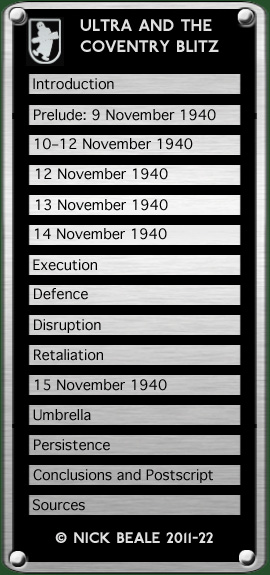continued …
Histories and memoirs have spoken of Churchill reviewing that day’s Ultra briefing but the only relevant items in the CX/JQ report issued at 02.40 next day were:
(1) a minor correction to a message about a previous day’s navigational beam setting;
(2) a commentary on Y-Service information about Moonlight Sonata whose only new point was that the D3R tuning signal had been intercepted at 13.00 GMT that day. (Overall reliability of this teleprint was rated as “(B)”); and
(3) the advice that “Source has some reason to believe that transmission on to-night’s target may start at 1700 (GMT), 14/11. No details of target yet available.” (Reliability of this teleprint was only “(C)”, the next-to-lowest level).
The file does not reveal the times at which these individual items were teleprinted from Bletchley but the second one must have come after the Air Staff’s paper was compiled since that only said that watch would be kept for the tuning signal, not that it had been sent.
NOTE: The National Archives' catalogue includes (as file HW1/1) a “Letter to C requesting daily service of messages for Prime Minister”, dated 27 September 1940 (“C” was the head of the Secret Intelligence Service, Brigadier Stewart Menzies). Sadly this file is missing and the surviving daily briefings only begin in March 1941, no help in elucidating what Churchill saw in the run-up to the Coventry Blitz
There is another file: HW1/3794, “Correspondence with C concerning officers in various ministries who were aware of or had access to Special Material”. This material, covering the 15 October–7 November 1940, shows the Prime Minister asking who in government and the armed services was seeing the decrypts. The lists are there, as is Churchill’s demandthat this “vast congregation” be greatly reduced but the circulation within SIS itself is not given. Churchill’s active involvement in ULTRA’s distribution over the six weeks prior to Coventry does not seem consistent with any suggestion that warnings were withheld from him.
|
 By 15.00 BST it had been established that the “river” beams were intersecting over Coventry and at 16.15 hours the order was given to Fighter, Bomber and Coastal Commands and to No. 80 Wing to execute Cold Water. An hour later, the Air Ministry approved this last formation’s detailed proposals for an attack on the Cherbourg transmitters. By 15.00 BST it had been established that the “river” beams were intersecting over Coventry and at 16.15 hours the order was given to Fighter, Bomber and Coastal Commands and to No. 80 Wing to execute Cold Water. An hour later, the Air Ministry approved this last formation’s detailed proposals for an attack on the Cherbourg transmitters.
In 1940 Peter Gray Lucas of the Air Ministry was working at the Cheadle Y-Service Station, on low-grade Luftwaffe tactical signals. In 1993 he wrote that:
A harbour defence command in Antwerp regularly received notice of ‘own’ aircraft about to fly over. On the afternoon of 14 November 1940 the signal read ‘ANGRIFF [attack] KORN’, but the [human] computors could not guess at the time and did not guess until later that KORN was the code-word for Coventry.
NOTE: Unfortunately, no reference is given for this message. Notifications of coast crossings by friendly aircraft from the 1944–45 period do exist but do not give intended targets, only the times and places at which the coast would be crossed, out- and inbound. Without sight of the original, it remains possible that Lucas’s memory was conflating two different messages.
|
continued on next page …

|

 By 15.00 BST it had been established that the “river” beams were intersecting over Coventry and at 16.15 hours the order was given to Fighter, Bomber and Coastal Commands and to No. 80 Wing to execute Cold Water. An hour later, the Air Ministry approved this last formation’s detailed proposals for an attack on the Cherbourg transmitters.
By 15.00 BST it had been established that the “river” beams were intersecting over Coventry and at 16.15 hours the order was given to Fighter, Bomber and Coastal Commands and to No. 80 Wing to execute Cold Water. An hour later, the Air Ministry approved this last formation’s detailed proposals for an attack on the Cherbourg transmitters.